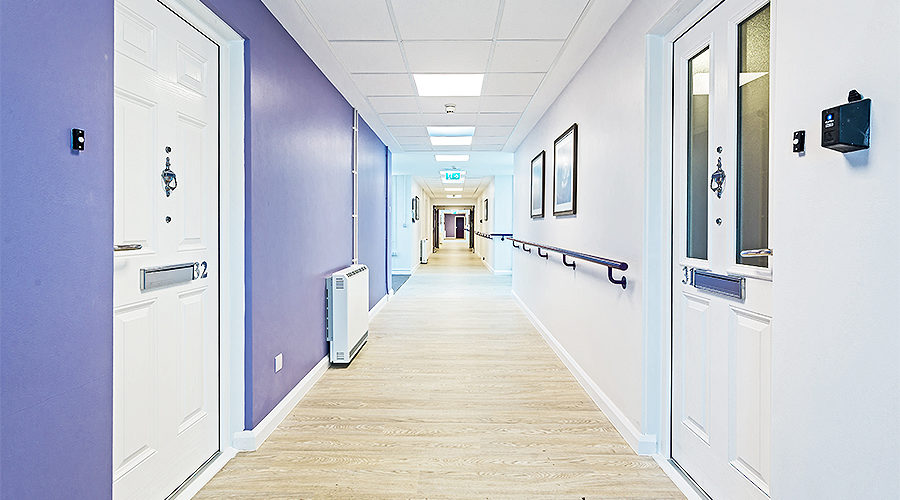With many councils facing a growing financial crisis, they are being forced to do more with less. Services are being scaled back with some being cut altogether. Amidst acute funding pressures, this creates undeniable challenges for those responsible for procuring products and services for property repair and maintenance and, indeed, new-build housing schemes.
Distinction Doors
They must have complete confidence in the products they are buying and whom they are buying them from,” comments Owen Jones, Technical Director at Distinction Doors, the stockist and distributor of the fds (fire door systems) fire door range. “They want to know they are investing in the best possible solution, and this is underpinned by robust and trustworthy service.”
Nowhere is this more apparent than in fire safety products.
“Understandably some people hesitate when it comes to specifying and installing fire protection. There have been, and continue to be, a lot of changes surrounding fire safety in the built environment, and this causes anxiety, not just for construction professionals but for the building occupants, too. In our experience, decision makers are looking to the supply chain for expertise and assurances, and we have a responsibility to deliver this at every stage of the process,” continues Owen.
Distinction Doors defines these stages as specification, procurement, manufacture, installation and maintenance.
“Fire doors are one product area that is still confounding, especially composite fire doors. As an industry, which includes members of the Association of Composite Door Manufacturers (ACDM), we are working tirelessly to educate and inform specifiers and decision makers of the significant advances, including robust testing, third-party certification and supply chain transparency. It is vital that we raise awareness of modern composite fire door capabilities to help solve the relentless demand for proven, compliant and consistent fire safety products.
Supporting specification and procurement
“Each stage presents its own challenges, but it is essential that specification is addressed appropriately because everything else follows. At a basic level, specifiers must seek confirmation of independent and verified test results, consistent performance, compliance and certified manufacturers and installers. Beyond this, there is now also the option to appoint GQA-accredited fire door inspectors, installers and maintainers. Only then can the scope of the product range be considered.
Certification and compliance
A high-performance composite fire doorset will be independently tested to British Standard BS 476-22:1987 and the more demanding European test method BS EN 1634-1:2014. This is denoted using FD30 and E30, respectively, proving a minimum of 30 minutes of integrity.
For internal applications, the fire doorset must also meet the demands of EN 1634-3:2004 (ambient smoke control). For external use, compliance with BS 6375 (weathertightness) is required. Compliance with Approved Document L (thermal performance) is mandatory in either setting. Currently, PAS 24:2022 (security) is only mandatory for new-build projects; however, it is often required and specified for refurbishment projects, too. It can be strengthened by additional Secured by Design status, which independently verifies compliance with the Police Preferred Specification.
These tests must be conducted by a third party and certificated using an independent United Kingdom Accreditation Service (UKAS)-accredited test house and/or certification body.
Supply chain confidence
“As with many building products, the fire door supply chain is onerous,” says Owen. “There are all the components associated with the complete fire doorset and their suppliers, and then there’s the doorset manufacturer, more commonly known as the fabricator, the installer – sometimes this service is also provided by the manufacturer, or it is outsourced. Some local authorities still command a fitting team, although this is rare nowadays. Once the doorset is installed, it’s over to the facilities and maintenance team of the associated council. Increasingly, fire door maintenance and inspections are also being outsourced.”
Voluntary audits
To combat the complexities, several composite fire door suppliers are taking control of their supply chain. This not only significantly reduces risk but also promotes stakeholder confidence and goes some way to meet the demand for improved product traceability.
“We mandate our supply chain, auditing our manufacturing partners to meet the non-mandatory requirements of Q-Mark STD 170 and STD 050 under BM Trada. Being voluntary, this clearly demonstrates a commitment to quality and offers a strong competitive edge, with more tenders requesting third-party certification as awareness increases.
“This way, we can control all components associated with our fds fire door system, apart from the door closers and sealed units, which must match the tested specification and prevent dilution of the supply chain – a critical factor in the supply, installation and maintenance of fire doorsets.”
Fire door installation
While progress has been made in the supply chain, there is still the matter of competent installation and robust maintenance – both essential to consistent fire-resistant performance and critical in the lifecycle of these products.
“Some installation companies have recognised a demand for third-party certification and have taken steps to achieve this; something that we encourage. The BM TRADA Q-Mark Fire Door Installation scheme has been “…Designed to provide reassurance to specifiers, contractors and end users that the product they have chosen has been installed correctly and that it should perform as intended.”
“Local authorities would do well to seek installation companies that meet the requirements of Q-Mark STD 052 and demonstrate competence in the installation of fire doors. This can sometimes be the same supplier that fabricates the fire door – in reality, there is no one more competent.”
Door data tags
While voluntary, the increasing use of data tags in fire doorsets will likely drive manufacturers and installers to seek formal qualifications to ensure professional and compliant production, installation and maintenance of the fire doorset.
The data tags hold the ‘Golden Thread’ of information, which provides complete traceability for the doorset and proves effective management and a responsible approach to fire door compliance. Undoubtedly, this will give local authorities the confidence to choose composite fire doorsets for new-build and replacement projects.











